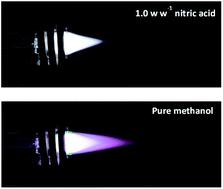当前位置:
X-MOL 学术
›
J. Anal. At. Spectrom.
›
论文详情
Our official English website, www.x-mol.net, welcomes your feedback! (Note: you will need to create a separate account there.)
Analytical performance of the Conical torch in inductively coupled plasma optical emission spectroscopy operating methanol and 1-propanol solutions
Journal of Analytical Atomic Spectrometry ( IF 3.4 ) Pub Date : 2020-10-14 , DOI: 10.1039/d0ja00368a Guillermo Grindlay 1, 2, 3, 4 , Sina Alavi 5, 6, 7, 8 , Javad Mostaghimi 5, 6, 7, 8
Journal of Analytical Atomic Spectrometry ( IF 3.4 ) Pub Date : 2020-10-14 , DOI: 10.1039/d0ja00368a Guillermo Grindlay 1, 2, 3, 4 , Sina Alavi 5, 6, 7, 8 , Javad Mostaghimi 5, 6, 7, 8
Affiliation

|
This work explores, for the first time, the strengths and weaknesses of the Conical torch in ICP-OES operating methanol and 1-propanol solutions ranging from 30% to 100% w w−1. To this end, Conical torch performance has been evaluated considering: (i) plasma fundamental properties; (ii) plasma robustness; (iii) carbon-based background emission; and (iv) analytical figures of merit. For the sake of comparison, a Fassel torch has been employed as a reference. Results show that the discharge for the Conical torch is highly robust and plasma characteristics (i.e., excitation temperature and electron number density) are mostly unaffected by the introduction of pure and hydroalcoholic solutions of methanol and 1-propanol. In contrast, the discharge for the Fassel torch is severely affected by organics introduction and it is not feasible to operate methanol solutions above 30% w w−1. Because torch geometry and improved gas flow patterns, the Conical torch affords higher emission signal (2-fold) than the Fassel torch. Nevertheless, the detection limits for both torches are comparable, which is due to the increase in both (carbon-based) background emission and signal noise for the Conical torch. From these results and considering that the Conical torch requires less r.f. power (35%) and argon consumption (55%) than the Fassel one, it is beyond doubt that the former torch is more advantageous for those applications requiring the analysis of alcohol solutions (i.e. extraction procedures and chromatographic separations).
中文翻译:

锥形炬在甲醇和1-丙醇溶液中的电感耦合等离子体发射光谱中的分析性能
这项工作首次探讨了使用30%至100%ww -1的ICP-OES操作甲醇和1-丙醇溶液时锥形炬的优缺点。为此,对锥形炬的性能进行了评估,考虑到:(i)等离子体的基本特性;(ii)血浆坚固性;(iii)碳基背景排放;(iv)品质因数分析。为了进行比较,我们使用了Fassel火炬作为参考。结果表明,锥形割炬的放电具有很高的鲁棒性和等离子特性(即,激发温度和电子数密度)在很大程度上不受引入甲醇和1-丙醇的纯净水醇溶液的影响。相反,Fassel火炬的放电受到有机物的引入的严重影响,操作高于30%ww -1的甲醇溶液是不可行的。由于割炬的几何形状和改进的气流模式,锥形割炬的发射信号比Fassel割炬的发射信号高(两倍)。尽管如此,两个割炬的检出限是可比较的,这是由于锥形割炬的(碳基)背景发射和信号噪声都增加了。根据这些结果,并考虑到锥形炬管的射频功率(35%)和氩气消耗(55%)比Fassel火焰管少,毫无疑问,前者炬管对于需要分析酒精溶液的应用更为有利(即提取程序和色谱分离)。
更新日期:2020-11-03
中文翻译:

锥形炬在甲醇和1-丙醇溶液中的电感耦合等离子体发射光谱中的分析性能
这项工作首次探讨了使用30%至100%ww -1的ICP-OES操作甲醇和1-丙醇溶液时锥形炬的优缺点。为此,对锥形炬的性能进行了评估,考虑到:(i)等离子体的基本特性;(ii)血浆坚固性;(iii)碳基背景排放;(iv)品质因数分析。为了进行比较,我们使用了Fassel火炬作为参考。结果表明,锥形割炬的放电具有很高的鲁棒性和等离子特性(即,激发温度和电子数密度)在很大程度上不受引入甲醇和1-丙醇的纯净水醇溶液的影响。相反,Fassel火炬的放电受到有机物的引入的严重影响,操作高于30%ww -1的甲醇溶液是不可行的。由于割炬的几何形状和改进的气流模式,锥形割炬的发射信号比Fassel割炬的发射信号高(两倍)。尽管如此,两个割炬的检出限是可比较的,这是由于锥形割炬的(碳基)背景发射和信号噪声都增加了。根据这些结果,并考虑到锥形炬管的射频功率(35%)和氩气消耗(55%)比Fassel火焰管少,毫无疑问,前者炬管对于需要分析酒精溶液的应用更为有利(即提取程序和色谱分离)。

























 京公网安备 11010802027423号
京公网安备 11010802027423号